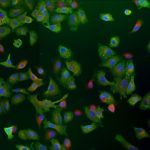Lien vers Pubmed [PMID] – 29202037
mSphere 2017 Nov-Dec;2(6)
The optimized exploitation of cell resources is one cornerstone of a successful infection. Differential mapping of host-pathogen protein-protein interactions (PPIs) on the basis of comparative interactomics of multiple strains is an effective strategy to highlight correlations between host proteome hijacking and biological or pathogenic traits. Here, we developed an interactomic pipeline to deliver high-confidence comparative maps of PPIs between a given pathogen and the human ubiquitin proteasome system (UPS). This subarray of the human proteome represents a range of essential cellular functions and promiscuous targets for many viruses. The screening pipeline was applied to the influenza A virus (IAV) PB2 polymerase proteins of five strains representing different levels of virulence in humans. An extensive PB2-UPS interplay has been detected that recapitulates the evolution of IAVs in humans. Functional validation with several IAV strains, including the seasonal H1N1 and H3N2 viruses, confirmed the biological relevance of most identified UPS factors and revealed strain-independent and strain-specific effects of UPS factor invalidation on IAV infection. This strategy is applicable to proteins from any other virus or pathogen, providing a valuable resource with which to explore the UPS-pathogen interplay and its relationship with pathogenicity. Influenza A viruses (IAVs) are responsible for mild-to-severe seasonal respiratory illness of public health concern worldwide, and the risk of avian strain outbreaks in humans is a constant threat. Elucidating the requisites of IAV adaptation to humans is thus of prime importance. In this study, we explored how PB2 replication proteins of IAV strains with different levels of virulence in humans hijack a major protein modification pathway of the human host cell, the ubiquitin proteasome system (UPS). We found that the PB2 protein engages in an extended interplay with the UPS that evolved along with the virus’s adaptation to humans. This suggests that UPS hijacking underlies the efficient infection of humans and can be used as an indicator for evaluation of the potential of avian IAVs to infect humans. Several UPS factors were found to be necessary for infection with circulating IAV strains, pointing to potential targets for therapeutic approaches.



